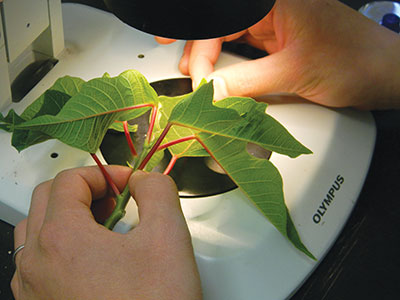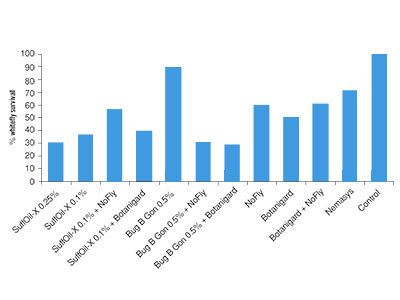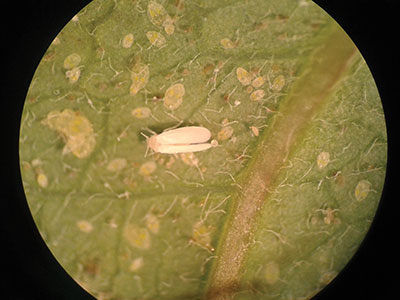
Features
Biocontrols
Inputs
Off to a clean start
April 16, 2014 By Rose Buitenhuis Michael Brownbridge Graeme Murphy Angela Brommit and Taro Saito
Poinsettia growers will remember the 2012 growing season, when high
numbers of Bemisia whiteflies came in on the cuttings and were very hard
to control.
Poinsettia growers will remember the 2012 growing season, when high numbers of Bemisia whiteflies came in on the cuttings and were very hard to control.
 |
|
| Counting whiteflies on a poinsettia cutting. Photo by Paul Côte Advertisement
|
Biocontrol programs, which had been very successful in previous years, were under pressure from the beginning with high whitefly populations making it difficult to get control using parasitic wasps. In addition, these hitchhiking whiteflies had already been exposed to many different pesticides and could not be controlled with previously effective products such as Forbid.
Luckily, 2013 was a much better year and poinsettia cuttings arrived relatively clean. However, this experience has taught us that new tools are needed to disinfest cuttings, so that growers can be sure to start with a clean crop every year.
Why dips? Reduced risk products such as soaps, oils or microbes are ideal for this purpose. They will kill whiteflies fast and leave minimal residues so biocontrol can be used almost immediately after treatment.
However, applying these products the regular way, by spraying, frequently does not provide the coverage that is needed for effective control, especially on the underside of the foliage, and is also quite labour intensive. Immersion treatments, or dips, will cover the whole cutting and are easy to integrate into the workflow before the cuttings are stuck.
Based on previous research at the University of Guelph and preliminary trials using reduced risk pesticides, five products were tested as cutting dips, individually and as combinations.
Experiments were designed to closely resemble commercial practices.
Cuttings were taken from poinsettia stock plants that were infested with whiteflies. After counting the whiteflies on the cuttings, they were dipped, stuck into Oasis rooting wedges and placed in a greenhouse under misting.

|
|
| Figure 1. Survival of Bemisia two weeks after dipping the poinsettia cuttings.
|
Two weeks later, the number of surviving whiteflies on the cuttings was determined (Figure 1). The cuttings were then grown on in the greenhouse for an additional eight weeks to see how whitefly populations developed over time.
Further experiments determined the phytotoxicity of various concentrations of dips and their compatibility with whitefly parasitoids.
When cuttings were dipped into SuffOil-X and Bug B Gon (insecticidal soap) at the recommended spray rates, phytotoxic effects were seen after a few days. Rates have to be reduced significantly if these products are to be used as dips.
The most effective dips were: Bug B Gon 0.5 per cent + Botanigard 1.25g/L, Bug B Gon 0.5 per cent + NoFly 3g/L and SuffOil-X 0.1 per cent. Only 30 per cent of the whiteflies survived (Figure 1). Bug B Gone increased the efficacy of both Botanigard and NoFly.
Dipped plants had lower whitefly populations after eight weeks.
The phytotoxicity of the best dips was acceptable and there was minimal to no effect of the dip residues on parasitoid survival.
 |
|
| Bemisia whitefly lifestages on a poinsettia leaf. Photo by Erfan Vafaie.
|
This project shows that dipping poinsettia cuttings can safely reduce whitefly populations to levels where they can be effectively managed with recommended biocontrol strategies throughout the remainder of the growing season.
By using products based on soap, oil and fungi for dips and biocontrol thereafter, resistance issues of whiteflies can be overcome.
The next steps are to integrate dips into IPM programs for poinsettia, do on-farm trials and assess the costs and benefits of this strategy as compared to conventional practices. Also, the risk of disease transfer will be assessed to ensure that dipping will not promote the spread of plant pathogens.
These data will be used to obtain label expansions to include dips as an application method. Starting clean is the foundation for all IPM programs on any crop. Future research will apply the techniques that were developed in this project to the early prevention of other pests such as thrips, aphids and mites, and to other crops that are started from cuttings.
Rose Buitenhuis, Michael Brownbridge, Graeme Murphy, Angela Brommit, Taro Saito are researchers at the Vineland Research and Innovation Centre.
Print this page